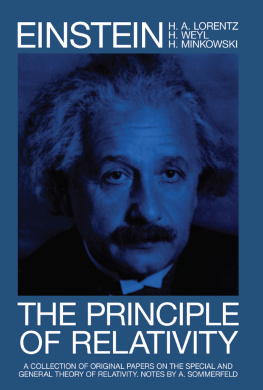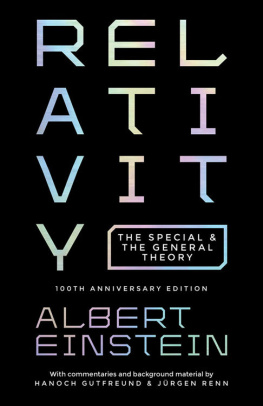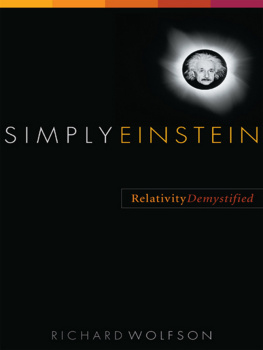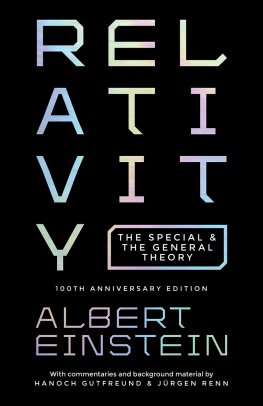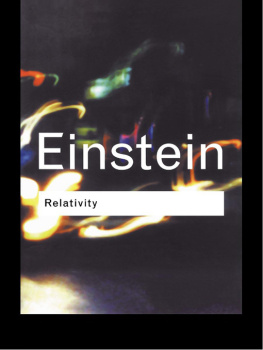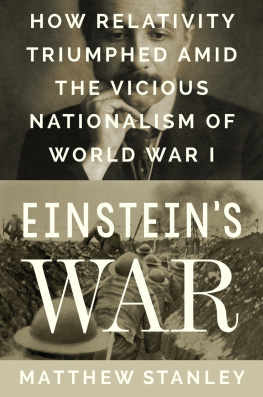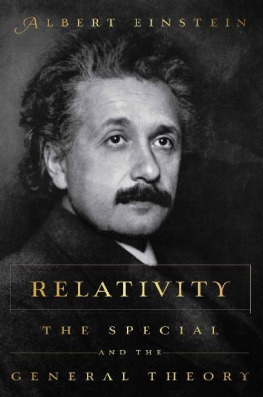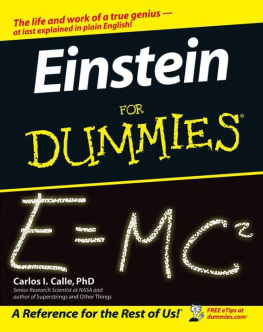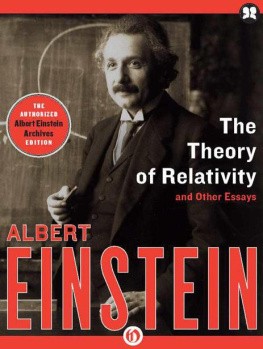Richard Wolfson - Simply Einstein: Relativity Demystified
Here you can read online Richard Wolfson - Simply Einstein: Relativity Demystified full text of the book (entire story) in english for free. Download pdf and epub, get meaning, cover and reviews about this ebook. year: 2003, publisher: W. W. Norton & Company, genre: Children. Description of the work, (preface) as well as reviews are available. Best literature library LitArk.com created for fans of good reading and offers a wide selection of genres:
Romance novel
Science fiction
Adventure
Detective
Science
History
Home and family
Prose
Art
Politics
Computer
Non-fiction
Religion
Business
Children
Humor
Choose a favorite category and find really read worthwhile books. Enjoy immersion in the world of imagination, feel the emotions of the characters or learn something new for yourself, make an fascinating discovery.

- Book:Simply Einstein: Relativity Demystified
- Author:
- Publisher:W. W. Norton & Company
- Genre:
- Year:2003
- Rating:4 / 5
- Favourites:Add to favourites
- Your mark:
- 80
- 1
- 2
- 3
- 4
- 5
Simply Einstein: Relativity Demystified: summary, description and annotation
We offer to read an annotation, description, summary or preface (depends on what the author of the book "Simply Einstein: Relativity Demystified" wrote himself). If you haven't found the necessary information about the book — write in the comments, we will try to find it.
Simply Einstein: Relativity Demystified — read online for free the complete book (whole text) full work
Below is the text of the book, divided by pages. System saving the place of the last page read, allows you to conveniently read the book "Simply Einstein: Relativity Demystified" online for free, without having to search again every time where you left off. Put a bookmark, and you can go to the page where you finished reading at any time.
Font size:
Interval:
Bookmark:
SIMPLY EINSTEIN
Relativity Demystified
RICHARD WOLFSON

W W NORTON & COMPANY
NEW YORK LONDON
For Irving Wolfson
and Leonard Swift
CONTENTS
Have you ever heard it said of a difficult idea that it would take an Einstein to understand this? What could be more incomprehensible to us non-Einsteins than Albert Einsteins own work, the theory of relativity?
But relativity is comprehensible, and not just to scientists. At the heart of relativity is an extraordinarily simple ideaso simple that a single English sentence suffices to state it all. Some consequences of that statement are disturbing because they violate our deeply held, commonsense notions about the world. Yet those consequences flow inexorably from a single principle so simple and obvious that it will take me just a few pages to convince you of its truth.
This books title, Simply Einstein, reflects the fact that the basic ideas of Einsteins relativity are accessible to nonscientists and make eminent sense. Even relativitys startling implications about the nature of space, time, and matter follow so directly from those basic ideas that they, too, become not only comprehensible but also logically inevitable.
Relativity is behind many of the hot topics at the frontiers of modern physics, astrophysics, and cosmologytopics ranging from black holes to the ultimate fate of the Universe to the prospects for time travel. Ill touch on these topics here, and youll see how they flow from the essential ideas of relativity. But my main purpose is not to explore the latest frontiers of physics. There are plenty of good books on those topics, and Ive included some in the Further Readings. Rather, this is a book that aims to give you, its reader, a clear understanding of just what it was that Einstein said about the ultimate nature of physical reality. To help you get there, well be exploring together the history of ideas that culminated in Einsteins simple but remarkable vision. Then youll see how that vision alters your commonsense notions of space and time in ways that would let you travel a thousand years into the future in just a few short hours. Youll come to a new understanding of past and future that might surprise historians, and youll begin to feel at home in the four-dimensional universe of relativistic spacetime. Along the way Ill anticipate your frequent questions: Why cant anything go faster than light? Will I really age more slowly, or is this just something that happens to physicists clocks? Can I go backward in time? What does E = mc2 really mean? Finally, in the end, well return to some of those contemporary hot topics that show just how prescient was Einsteins visionary insight.
You dont need to do math to grasp the essence of Einsteins relativity, and you dont need math to understand this book. Occasional numbers can help make some points more concrete, and Ill use them sparingly. Whats important here are the big ideasand theyre all expressed in words. Grasp those ideas, and you know what Einsteins relativity is all about. Enjoy!
Could the Universe have created itself? What an absurd idea! Did the Universe even have a beginning? That question, too, has an absurd ring. If there was a beginning, what came before? Wasnt that part of the Universe too? Or has the Universe always existed, begging the question of its own origin?
Whatever the answers to these questions, modern astrophysics makes one thing clear: our Universe hasnt existed forever unchanged. Rather, its evolved from an earlier state of extreme temperature and density. Some 14 billion years ago, all the stuff that makes up ourselves, our planet Earth, and all the stars and galaxies was crammed into a volume far smaller than a single hydrogen atom or even the tiny proton at its core. The expansion of that extreme state is the Big Bang that describes the Universes subsequent evolution and ultimately accounts for the origin of stars, galaxies, planets, and intelligent life.
What came before the Big Bang? What created that early, extreme state? Were back to the primordial question: Did the Universe have a beginning, or has it always existedalbeit an existence marked by evolutionary change?
To some cosmologistsscientists who concern themselves with the origin and evolution of the Universethe start of the Big Bang marks the start of time itself. For them, it makes no sense to ask what came before because the concept of before is meaningless if theres no such thing as time. Others have envisioned an ever existing Universe that undergoes a series of oscillations. Each begins with a Big Bang and subsequent expansionthe phase were now inthen eventually contracts toward a Big Crunch of extreme density and temperature that starts another cycle.
In 1998 Princeton physicist J. Richard Gott and his student Li-Xin Li published a novel answer to the ultimate question of the Universes origin. Their paper, Can the Universe Create Itself?, shows how the laws of physics may allow a time loop , in which time goes round and round in a circlelike structure rather than advancing inexorably into a never-before-experienced future. Like Bill Pullmans character in the film Groundhog Day , an occupant of the time loop might go to bed at night and wake up on the morning of the day before! The new day would unfold, night would come, and again the morning would bring the already familiar day. In this loop, time advances circularly into a future that is a recycling through past events. Theres no earliest event, any more than any point on a circle can be called the beginning of the circle or any point on Earths surface is the place where our planet starts.
Gotts time loop doesnt sound like a description of our Universe, but hold ontheres more. Time, in Gotts theory, can branch, providing different paths to different futures. Gott envisions a universe whose earliest epoch includes a time loop. Every point on the loop both precedes and follows every other point. There is no beginning instant, because one can always trace time further back round the loop. But theres a branch out of the time loop, a branch into a more normal realm of time that advances, without repetition, to a future of never-before events. Thats the kind of time we know, with an as-yet-unknown, yet-to-occur future. Figure 1.1 depicts Gotts time-loop, multibranched universe.
Its the branching that reconciles Gotts time loop with the more ordinary time we experience today. The time loop unambiguously precedes our present, and in that sense its closer to the beginning. But trace time backward, through the branch and onto the loop. You can keep tracing back but youll never find a beginning. Instead, events repeat as your historical exploration circles backward around the loop. Theres no one event that marks the creation of this universe. Every event on the time loop precedes every other event, and in that sense Gotts universe creates itself. Absurd!

Fig. 1.1 Gotts time-loop universe. Arrows represent multiple directions of time, including the circular time loop at the beginning, in which time goes round and round in an ever repeating sequence. Circular cross sections of the trumpets represent position in a single spatial dimension, and each trumpet is its own universe. Is this absurd? Maybe not, says the theory of relativity. (Adapted with permission from J. Richard Gott and Li-Xin Li, Can the Universe Create Itself? Physical Review D 58 (1998), p. 3501.)
How Many Universes Did You Order?
Surely, The Universe encompasses all that there is. Thats the root meaning of the word, as in universal. But not according to Stanford University cosmologist Andrei Linde. For the Russian-born Linde, our Universe is but one small branch of a possibly infinite Multiverse . What we think of as the Big Bang origin and evolution of the Universe is, to Linde, simply the budding and subsequent expansion of a new branch from a pre-existing cosmos. That branch is our Universe. Other branches are different universes, each of which has had its own big bang and its own evolutionary scenario. Remarkably, each universe may even have its own laws of physics. The budding that produces a new universe may result in mutations from the laws that govern the parent branch. Together, all these interconnected universes form the Multiverse or, in Lindes more dynamic phrasing, the self-replicating inflationary universe. Our own Universe may someday spawn new buds that become entire universes; in fact, it may already have done so. It might not even take much effort to initiate such a bud. Cosmologist Alan Guth of MIT has suggested that with an ounce of material, crushed to high enough density, you might start a new universe right in your own garage! Perhaps we and our whole Universe are just the results of someones experimentation in another branch of the Multiverse.
Next pageFont size:
Interval:
Bookmark:
Similar books «Simply Einstein: Relativity Demystified»
Look at similar books to Simply Einstein: Relativity Demystified. We have selected literature similar in name and meaning in the hope of providing readers with more options to find new, interesting, not yet read works.
Discussion, reviews of the book Simply Einstein: Relativity Demystified and just readers' own opinions. Leave your comments, write what you think about the work, its meaning or the main characters. Specify what exactly you liked and what you didn't like, and why you think so.

